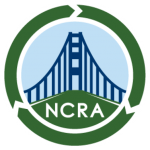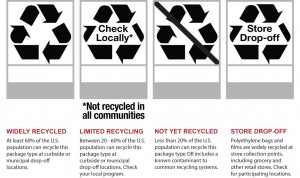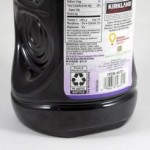So Waste Management Admits Failure At Recycling, But Who’s Really To Blame?
A Critical Review of the Aaron Davis’ June 20 Washington Post Attack on Environmentalists and Real Recyclers – American Recycling Is Stalling And The Big Blue Bin Is One Reason Why
By Daniel Knapp, CEO of Urban Ore, Inc., a Materials Recovery Facility now celebrating its 35th year in Berkeley, California, 7/7/15
Forty-five years after the first Earth Day jump-started recycling, companies like mine, Urban Ore, are one big reason why publicly traded wasting companies like Waste Management are losing market share and profitability. Our secret: we’re small, we’re nimble, and we focus on handling the disposal functions by producing quality resources from the municipal discard supply. In short, we’re just the opposite of the flawed recycling systems that are bringing down giants like Waste Management, Inc. When last counted, in 2004, there were about 56,000 of us, chipping away at the big waste companies’ market share. Eleven years later, there are probably more of us, and we’ve grown.
Meanwhile, the wasting giants have made some big bad bets, then pursued them with bullheaded efficiency, egged on by their corporate boardrooms. Big money is the driver in these transactions, not recycling markets. They bet that throwing investor money at highly automated but extremely dirty collection and sorting systems would best allow them to pursue their dreams of market domination. It worked for a while, but now we’re told it wasn’t sustainable. Aaron Davis of the Washington Post reports that at the highest levels of Waste Management, they appear to be giving up. He likes to reduce their key technology to “the big blue box,” but more experienced people know it as “single-stream.”
Single-stream’s essence is to combine all residential recyclables, mix them thoroughly, then try to separate them using automated systems developed for simpler feedstocks by the mining industry. Single-stream is notorious among real recyclers and perceptive environmentalists alike, many of whom not only saw through the industrial strategy from the first, but correctly forecast the outcomes now coming to pass.
Despite overwhelming evidence to the contrary, Aaron Davis blames environmentalists in general, and California environmentalists in particular, for Waste Management’s failures to make single-stream recycling profitable. He appears to have gotten most of his ideas from the Waste Management people he interviewed. But he didn’t talk to the competition at all, so what did he expect to hear but the backpedaling and evasiveness that he got? And why did the editorial staff of The Washington Post let him get this misinformation and disinformation into print?
The following quotes about single-stream’s failures show that Mr. Davis was wrong to blame environmentalists for the collapse of Waste Management’s recycling businesses. I’m indebted to environmentalist Lynne Pledger of Massachusetts Clean Water Action for most of these quotes, which she put out four years ago, in 2011 in a paper entitled
Concerns With Single Stream Recycling Collection (pdf).
Also, all bolds are mine. If you want to get to the gist of this refutation, read only the boldface in what follows.
Since Mr. Davis singles out California in his hit piece, let’s start with California environmentalist and recycling activist Portia Sinnott. She’s currently Editor of the monthly newsletter of the Northern California Recycling Association. She has been a NCRA Director for decades and served as its President for several years. More recently she has presided over a series of meetings called The Zero Waste Brain Trust that drew working recyclers from all over the state. One big takeaway from these meetings, Portia said two years ago, was that “…a growing number of waste professionals think the current design of MRFs — Material Recovery Facilities — are creating more garbage rather than less.”
The critique of single-stream goes back many years. As early as 2002, St. Paul, Minnesota’s Eureka Recycling study of competing collection and processing methods said that single-stream systems, “with high residual rates, expensive processing, and the lower quality in materials, …presents concerns…. The cost advantages and efficiencies of single-stream…disappear the more closely one looks at the later stages of the recycling process.” This was printed thirteen years ago in Resource Recycling, November 2002, one of several magazines that cover the recycling industry.
Just two weeks ago, Tim Brownell and Bryan Ukena, the current co-managers of Eureka Recycling, posted the following response to Mr. Davis’ thesis that waste companies are not to blame for their failed systems: “How dare WMI, Republic (formerly BFI) and the other largest garbage/landfilling companies in North America play victim to Single Stream recycling (?) Almost 15 years ago they began the steady march away from collecting recycling in separated streams, which allowed for the highest value and most environmental benefit from the materials. They claimed Single Stream systems were the future to recovering the most materials and to being the most efficient and environmentally effective programs possible for communities all across the country. It also happened to work well in their compacting garbage trucks. In Minnesota, due to these companies’ “vision” and influence, over 80% of all materials are now collected and processed in this manner. And NOW they have the gall to say the system is broken. ‘Not enough Profits’ is their mantra.” “Looking back 15 years ago we heard a very similar story from the multinational garbage companies as they purchased all of the local recycling companies, stating that recycling wasn’t working, and that they needed to raise fees for services by 40%.”
The big waste companies’ preference for single-stream undercut the finances of the companies that use recycled feedstocks. Clarissa Morawski wrote an influential report on single-stream for the Container Recycling Institute in 2009 that concluded “...the cost savings for a municipality from single-stream collection show up as cost increases for the processors and remanufacturers. The contaminants are thrown away by the paper mills. So, an item such as a plastic bottle that was recyclable when it was placed at the curb becomes trash by the time it is sorted out as a contaminant by the paper mill.”
In the same vein, Sacia and Simmons, writing in the TAPPI Journal, stated that “…Increased equipment wear, due primarily to glass and other abrasive contaminants, has increased maintenance costs (for paper makers) more than 300%. Pulper rejects, which are landfilled and consist primarily of plastics, tin, glass, and aluminum, have increased 800%. Other fiber-related costs have increased by 740%.”
These are business-busting numbers, and they came out nine years ago. But Waste Management and the other big wasting companies went ahead with single-stream anyway. Ideology triumphed over practicality.
What’s a self-respecting government to do? The Department of Ecology (pdf) of the State of Washington recommended in 2010 that local governments “switch the focus from collection to recovery…. Diverting materials from the garbage can to the point of collection when those materials end up disposed at a processor or remanufacturer…is not recycling or diversion,” they said. Many other governments agreed.
Manufacturers complained, too. In 2011, the Environmental Paper Network (pdf) asked its member companies to devote more time and energy to “…resolving the challenges created by single-stream collection programs that drive up the cost of recovered paper fiber and increase contamination.”
That same year, Lynne Pledger of Massachusetts Clean Water Action (pdf) wrote that single-stream was distorting markets worldwide. “Paper collected in a single-stream system is marketed to low-value uses like paperboard, much of which goes to overseas mills, rather than high-quality uses like fine printing and writing paper. This is having an adverse effect on domestic (paper) mills…and making it harder for those who want to purchase recycled paper to find it. (Also), …the container stream is contaminated with paper…. Overseas markets will accept contaminated material more readily than domestic markets, so that when world markets are robust there is less concern in the US about high-quality recyclables. But when markets go down which happens cyclically, it is the cleanest materials that find a home. Single-stream materials are excluded or marketed at a significant loss.”
Single-stream is only one of several wasting industry technologies now causing trouble for big waste companies’ sunk assets. In 2010, I wrote in a piece for the newsletter of the Northern California Recycling Association (NCRA) about…a sad list of waste company versions of “recycling” such as garbage composting, dirty MRFing, single-stream collection, and Alternative Daily Cover, or ADC, that systematically waste materials that could easily be conserved and used. From an operations perspective, they all look like greenwashing to my jaundiced but experienced eye. Garbage in, garbage out.”
NCRA is on the worldwide web, along with several other big recycling-related NGOs such as the Berkeley Ecology Center and Eureka Recycling. Mr. Davis could have found a veritable symphony of these kinds of statements among real, feet on the ground recyclers had he bothered to look. But he didn’t, instead only quoting Patty Moore, a respected California consultant (and long-time NCRA member) closely associated with the plastics industry. Why would only Patty Moore get to stand in for tens of thousands of recyclers and environmentalists?
Maybe because plastics are so hard to recycle effectively. In their July 2015 newsletter, The Container Recycling Institute reproduced an interesting article from the Winona, Minnesota Daily News about a study being done there by longtime recycling and environmental activist Ann Morse. The study was designed to find out just what people are mistakenly putting into the big blue bins in that rural county. More than 200 large samples were collected, their contents sorted and weighed. It turns out that the biggest Blue Bin contaminant by weight (and certainly by volume as well) is….unrecyclable plastics! Here’s the quote: “Nonrecyclable plastic was by far the largest contributor to the garbage bin, which slowly filled with things like pencil cases, plastic cups, chip bags, newspaper bags and grocery bags. While some bags are made of recyclable plastic, ordinary recycling facilities can’t handle them, Morse explained, so they should only be recycled in special collection areas in stores. Whenever recyclables are placed in a plastic bag, the whole bag is discarded as waste, which defeats the purpose of recycling in the first place. Paper bags, on the other hand, can be recycled along with their recyclable contents.”
So I would say Waste Management has itself, and to some extent the plastics industry, to blame for its recycling failures. Not consumers. Not environmentalists. Not working recyclers. Just them.
For residents of Washington DC, I’d say you’re getting half-truths at best from your beloved local newspaper, at least when it comes to recycling.
For those of us working to make that Zero Waste future happen – no burn, no bury, WMI’s failure is clearly an opportunity. That’s because we perform the same task of legal disposal for unwanted goods, but we do it better and more profitably because we focus on quality production from start to finish.
We don’t like to mix unlikes. We like order better than disorder when it comes to materials handling. We think that system designs that degrade materials unnecessarily should be replaced by systems designed by people who understand how to use source separation to produce high quality resources and jobs.
This transition to a true Zero Waste future is job #1 for the new millennium, in my opinion.


